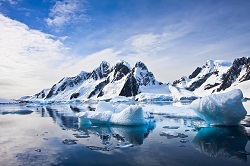Trending Science: Earth shifting on its polar axis due to climate change
Scientists and navigators have been accurately measuring the true pole and polar motion since 1899, and for almost the entire 20th century they migrated a bit toward Canada. But that has changed with this century, and now it’s moving toward the UK, according to study lead author Surendra Adhikari at Nasa’s Jet Propulsion Lab. The study has been published in the journal ‘Science Advances.’ Melting ice sheets, especially in Greenland but also in Antarctica, (that hold 99 % of the Earth’s freshwater reserves) are changing the distribution of weight on Earth. This highlights the very real and alarming impact of climate change on our planet. The study analysed satellite and land measurement data from 2003 to 2015 and applied it to how and why the Earth moves the way it does. While it's normal for the axis to move around a little bit, the recent shift has been more than expected. According to the study, since the beginning of the new millennium, the planet’s spin axis has wandered away from its normal range to the tune of about 75 degrees eastward. The tilt is caused by shifts in water distribution, thanks to the more than 396 trillion kilograms of ice that Greenland and west Antarctica lose per year. That, plus the 74 trillion kilograms that east Antarctica gains annually, puts more weight distribution towards the east, causing the planet to wobble on its polar axis. ‘That may seem like a tiny variation, but there is very important information embedded in that,’ said Dr Adhikari. ‘This shift has been on the order of 10 centimeters a year [since 2000], so it's probably not enough to warrant a recalculation of the planet's geographic pole… although later generations may have to consider it if things keep changing.’ However, it’s not just the shrinking glaciers at the two poles that are contributing to the change in the Earth’s polar axis. The research team also reports that a lot of mass also gets moved around due to large-scale loss of liquid from the land. They theorise that the rotational pole is shifting towards Europe also because there has been a large-scale loss of water from lakes and aquifers in Eurasia, around the Caspian Sea, and in India. Overall warmer temperatures have led to more evaporation and less precipitation in many regions of the world. From a human perspective, booming populations have been consuming more from reservoirs and wells. Dr Adhikari and his team hope their findings will help other climate researchers improve the general understanding of global forces. ‘We should be able to use polar-motion data to answer some interesting questions,’ says Adhikari. For example, the data could help make climate models more accurate, as scientists could work backwards from the robust archive on polar drift to infer the melting and evaporation rates of the past. Scientists might similarly be able to track how fast specific regions have dried out from drought. The end result could be better and more accurate predictions of changes in climate in the future, as well as a better understanding of how the Earth spins through space.
Countries
United States



